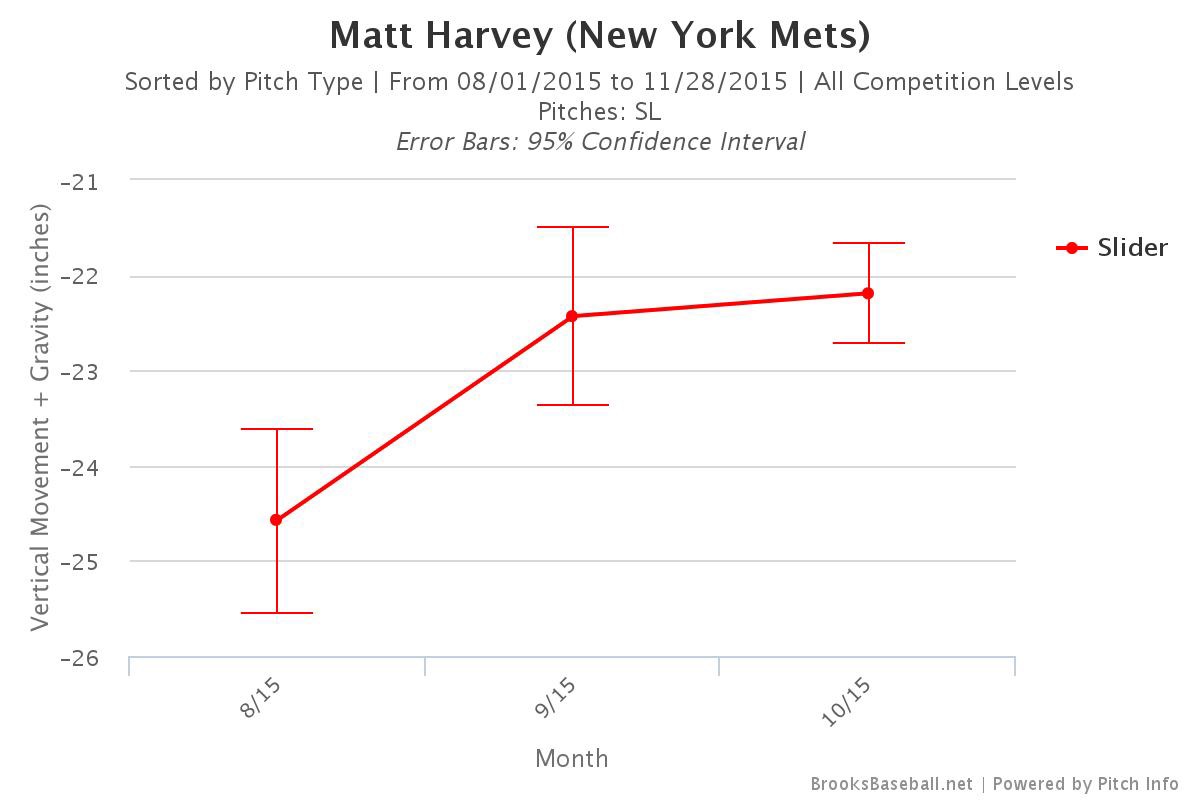Is Harvey’s Slider Really Back?

So far, the big Matt Harvey story of the preseason is the return of his vaunted slider. According to Harvey, he did not have it for most of last year.
For what it’s worth, Spring Training is always full of stories pumping up players. Every player appears to be in the best condition of their life. Players are healthier than they have ever been in their career. They’re either ready to build upon a strong season or put a tough season behind them. Does the supposed return of Harvey’s slider fit into that catergory?
In 2013, Harvey’s breakout season, he was 9-5 with a 2.27 ERA, 0.931 WHIP, 157 ERA+, 2.01 FIP, and a 9.6 K/9. He threw his slider 18.5% (504 total) of the time. Rather than try to explain how his slider moved, here’s a two graphs from Brooks Baseball showing the vertical and horizontal movement of Harvey’s 2013 slider:

 When Harvey threw his slider, it was swung at 49.01% of the time. When batters swung at the pitch, it was fouled off 15.8% of the time. It generated a swing and miss 17.66% of the time, and it was put into play 16.88% of the time. When contact was made, it typically generated a groundball. He only allowed two homeruns off of the pitch. In sum, it was a terrific pitch for him.
When Harvey threw his slider, it was swung at 49.01% of the time. When batters swung at the pitch, it was fouled off 15.8% of the time. It generated a swing and miss 17.66% of the time, and it was put into play 16.88% of the time. When contact was made, it typically generated a groundball. He only allowed two homeruns off of the pitch. In sum, it was a terrific pitch for him.
Now, if we use Harvey’s word that his slider didn’t return until the last quarter of the season, it means he didn’t have his slider until August. Again, using Brooks Baseball, here are graphs showing the vertical and horizontal movement of Harvey’s slider:


Taking a cursory look, Harvey’s slider had less horizontal and vertical movement. Unsurprisingly, the pitch was not as effective for Harvey.
From April to July, Harvey threw this slider less frequently than his old slider. His slider usage rate dropped from 18.5% to 15.12%. During these months, Harvey relied much more heavily on his fastball. Part of the reason for that might’ve been his lack of confidence with his slider.
When Harvey did throw his slider, it was swung at 43.92% of the time. When batters did swing at the pitch, they fouled it off 9.12% of the time, swung and missed 17.57% of the time, and put it in play 17.57% of the time. While the new slider did generate more groundballs, it did also generated less swings and misses.
More importantly, it needs to be reiterated that Harvey did not have the confidence in this pitch that he did in 2013. To an extent, it changed what he was as a pitcher, and the results showed. From April until July, Harvey went 9-7 with a 2.91 ERA, 1.06 WHIP, and an 8.5 K/9.
Harvey said he found his slider sometime in August. Here’s how his slider moved from August through the postseason:

 Looking at the charts, Harvey’s slider appeared to get its movement back, especially in August. What is surprising is that Harvey used his slider even less frequently than he had done in the first five months of the season. His slider usage rate dropped to 13.10%.
Looking at the charts, Harvey’s slider appeared to get its movement back, especially in August. What is surprising is that Harvey used his slider even less frequently than he had done in the first five months of the season. His slider usage rate dropped to 13.10%.
When he did throw it, it was more effective. Batters swung at the slider 53.03% of the time. When batters did swing at the pitch, it was fouled off 15.91% of the time, swung and missed 18.94% of the time, and put in play 18.94% of the time. Harvey’s rediscovered slider was able to generate a similar percentage of groundballs as he had between April – July.
To close out the regular season, Harvey was 4-1 with a 2.24 ERA, 0.927 WHIP, and a 10.1 K/9. While we should always be careful of drawing conclusions from short sample sizes, it appears that the 2013 Cy Young caliber version of Harvey is back.
Judging from Harvey’s first Spring Training start, he still has his slider. With that, Harvey should have increased confidence, and more importantly better stuff out there in the mound. Now that the slider will be back for a full season, Harvey is back in the Cy Young discussion (if he ever left), and he is primed to dominate the National League.